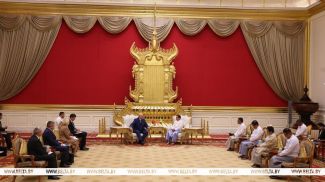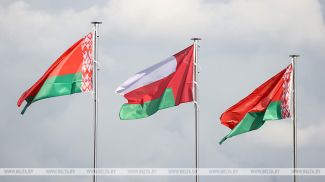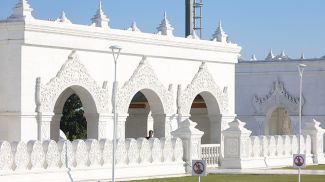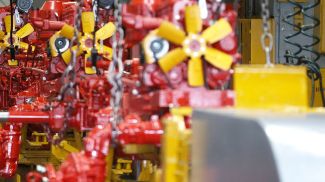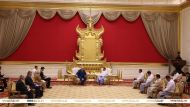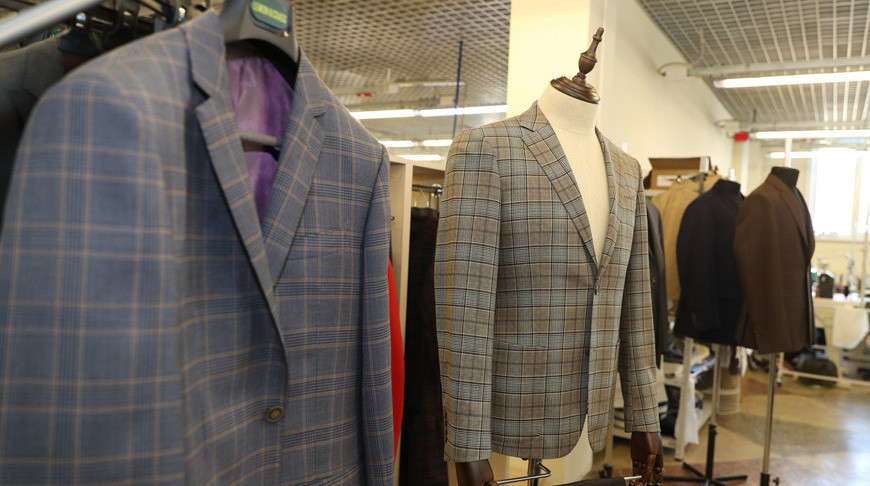
The end of 2012 was a momentous time for the Kamvol factory. At that time, Aleksandr Lukashenko was familiar with the real situation at the Minsk-based Kamvol. He postponed his visit to the factory several times in the hope that officials would take measures and put the factory in order at least by the president's visit. However, that did not happen. To say that the head of state was extremely dissatisfied with what he saw would be an understatement. Once the flagship of the Belarusian and even Soviet textile industry, Kamvol was in a deplorable state. People had to endure poor working conditions: a derelict building, outdated equipment and sub-zero temperatures in the workshops." The president dismissed the director general, the head of the Bellegprom concern and issued a final warning for the government. "What I've seen here is criminal negligence. You must immediately make a proposal on what we are going to do here. We need to create a normal environment for people,” Aleksandr Lukashenko said.
The head of state instructed to restore the worsted industry in Belarus and create a raw material base for it. In the new episode of BelTA’s YouTube project “After the Fact: Lukashenko’s Decisions” we will tell you how a city cotton factory turned into a legendary worsted mill. Why did every tenth meter of Belarusian fabric receive the State Quality Mark of the USSR? How did the company find itself in a difficult situation, and why did the president criticize the ministers for the window dressing attempt? What did the modernization of the worsted mill result in?
History of the worsted mill
The history of Kamvol, one of the largest light industry enterprises in the post-Soviet space, began in the middle of the last century. Post-war Minsk became the cultural and industrial hub of the country. In 1951-1955, more than 350 various plants and factories were put into operation in the BSSR. One of them was Kamvol. In August 1953, the BSSR Council of Ministers decided to build an enterprise to make worsted fabrics in Minsk. A big factory was up and running on the outskirts of the capital two years on.
"Our worsted mill was built in the place which was once a potato field. We can say that everything started from scratch. But enthusiasm, desire to build the new factory as soon as possible was sky high. When the first batch of equipment arrived, it was literally mounted in the open air. People really wanted to install the equipment immediately and get the factory off the ground,” the Znamya Truda newspaper cited Ivan Sitrov and Babir Aliyev, two front-line comrades who fought on the 1st Baltic Front, and who worked at the Minsk worsted mill after the war.
The reference guide to Minsk for 1956 noted: "The combing and spinning shops were up and running while the construction of the factory was still ongoing. The factory supplied tens of tonnes of finest durable woolen yarn to textile enterprises every month."
What is Minsk worsted mill famous for?
By 1960, the factory was fully operational. With the design capacity of 9,000m, Kamvol produced more than 10,000m of fabric. The factory took a special pride in its all-wool fabrics made of fine merino wool. Five years later, in 1965, Minsk worsted mill started to make production plans in accordance with consumer orders, as an economic experiment. That year the factory exceeded its design capacity by 1.5 times. Out of 34 names of manufactured products, 20 met international standards.
The Minsk worsted mill was equipped with world-class equipment. Raw materials were of top quality. Wool, for example, was from Australia. So, it was not surprising that every tenth meter of fabric had the State Quality Mark of the USSR. The mill worked 24/7 sending its fabrics to all corners of the Soviet Union and abroad.

Perhaps it is worth talking about the heroes of that time. Among them is Hero of Socialist Labor Zinaida Bychkovskaya. She came to work at the mill as an 18 year old girl and stayed with it for many years. "It was 38 years of eventful life," Zinaida Bychkovskaya recalled. While an average worker supervised 200 spindles, the young spinner handled 800. Zinaida Bychkovskaya was the living embodiment of the Soviet person. A hardworking, humble, beautiful woman. Such people were celebrated in books and films.

In the late 1970s, she actually chaired the Presidium of the Supreme Soviet of the BSSR. Such work required a different set of skills. However, this did not mean that she dropped her work at the spinning machine. Zinaida Bychkovskaya, as before, fulfilled and exceeded production targets. “I remember, one day our delegation returned from a working trip to Murmansk. The plane landed at 6 in the morning and at 8.00 I was already at work,” she said.

The situation at Kamvol in the 1990s
Diplomas, honorary titles, banners and orders, victories at national competitions - Minsk Worsted Factory and its workers received one award after another. Unfortunately, this could not last forever. The crisis of the 1990s had a tremendous toll on the domestic economy and the country’s industrial giants.
Nina Sinyak, decatizer of the textile finishing shop at Kamvol, started working at the factory on 20 July 1978. According to her, the company operated steadily back then. However, during the “perestroika” period, the work was reduced to 10-15 days.
“The salary was only a fraction of what it used to be. But the company tried its best to stay afloat. We did not quit. The 1990s was a very slow period for the company. It could hardly get hold of orders and raw materials. It was a tough time. We believed that the situation would eventually turn around. Although we faced multiple challenges, quitting was never an option for me. I was determined to stay. I was a very loyal employee. The president promised to help us and delivered on that promise: the factory was renovated. We moved to a new building, bought modern equipment. I am a decatizer and operate a decatizing machine. I learned a lot of new skills during this time. The company became a much better place to work. We got a sense of stability,” Nina Sinyak recalled.

At first things were not so bad. The enterprise's capacity and equipment allowed it to keep going for some time. However, soon the industry made a huge leap forward, knocking the Minsk manufacturer out of the market. Kamvol lost momentum and could not catch up.
Why was Lukashenko outraged by the situation at Kamvol?
Although it received government support, it became clear with years that it was in a dire need ofa major overhaul. In 2011, the company posted one billion rubles in losses. In 2012, the situation took a further turn for the worse: losses reached almost 10 billion, accounts payable exceeded 31 billion. The head of state had to intervene. How this played out for the management and the entire light industry concern was mentioned at the very beginning of this episode.
Back then journalists asked the president why he needed to personally inspect enterprises and to sort out problems in specific industries, sometimes making unpopular decisions. “If a president of the country does not go through workshops and study production processes, then this is not a president, at least in Belarus. A president must be well-versed in key industries and preferably understand main technological processes. Secondly, a president has to do it because others don’t do their job properly,” said Aleksandr Lukashenko.
The Kamvol upgrade became a kind of litmus test for the government. And the one who assesses the test results is very tough, as you know. Money was allocated, but the supply of equipment was delayed, and construction and installation works were not done properly and machines were not replaced in the right way. To make things worse, the debts from previous years were snowballing, while salaries had to be paid. So it was not clear whether the upgrade effort would pay off.
“Yesterday I chose not to visit this enterprise, although it was in my schedule. I did not go there because the minister started window dressing it. For a one-or two- day show, he gathered everything he could from the ministry, the concern. He brought raw materials there in order to start the machines for a day or two, only to stop them after the president’s departure, I guess. There were a number of other issues that should have been resolved before the president’s visit, including personnel issues. I will come to this enterprise without prior notice,” Aleksandr Lukashenko said as he was hearing out a report on the situation at Kamvol in December 2015.
The cost of the Kamvol upgrade program
The large-scale re-equipment of the factory cost €130 million; 99% of the enterprise had to be rebuilt. The company installed 320 units of the most advanced equipment. It changed the working process dramatically.
“The factory completed its major makeover in 2016-2017. Today we have cutting-edge high-performance equipment in all our workshops. Now our fabrics differ from Italian ones only in price. I am happy that our enterprise got a new lease on life. The personnel have been retained. Salaries, jobs have been secured. Upgraded workshops look great. The only thing that we still lack is specialists. We are working on the matter and doing our best to retain young specialists at the enterprise,” chairwoman of the Kamvol primary trade unions organization Galina Berestovaya.

According to the WTO data for 2017, China was the undisputed leader in the textile market. China’s trade in textile was estimated at $110 billion. The top ten also included the European Union, India, the United States, and Türkiye. Belarus also exports textile, though in much smaller amounts, at $1.2 billion. The figure looks modest in comparison with the world’s economic giants. But countries comparable to Belarus are not even mentioned in the textile exporters’ rankings.

“I came to congratulate you on the completion of Kamvol’s large-scale modernization. We started it a long time ago, had to cope with plenty of challenges. Many careers were ruined along the way. But I think we are firmly on the way towards our goal, namely to make good fabrics. There were two major reasons why I wanted to the company to go on. The first one is retaining jobs. The second one is retaining competences. I believe it is criminal to allow once flourishing manufacturers to bite the dust. It means the government fails at its job. It is a failure indeed. That is why the decision was taken to modernize this factory,” Aleksandr Lukashenko said as he met with the company’s workers in late 2017.
How is Kamvol doing today?
Today Kamvol is one of the largest fully integrated manufacturers of yarn, fabrics and clothing in the post-Soviet space. Just imagine: some 30 operations are needed to make fabric. It takes three months to process wool fiber and get finished fabric. The product line-up of the famous Minsk brand includes suit and dress fabrics, semi-sheer, knitted and woven yarns, men's and women's clothing. Last year the factory launched the production of cloth fabrics with a capacity of one million linear meters per year.

A competences center has recently been opened at Kamvol. The center will offer on-the-job training for those who receive specialized vocational, secondary and higher education.
According to Bellegprom chairperson Tatiana Lugina, the enterprise has a lot of tasks to accomplish and they are diverse.
“We seek to reach the maximum capacity utilization and develop a production matrix to ensure the factory’s profitability. The task of developing the human resources potential remains high on the agenda as well. Our production program will focus on products with the wool content of 70% and more, semi-woolen fabrics and products made of them (with the wool content of 15% to 45%). Polyviscose fabrics will also make up some 30-35% of our production plan this year. We aim to use it to make school clothing. Over the past 5-7 years such clothing has been highly popular, both with boys, girls and adults,” Tatiana Lugina said.
Kamvol also looks to strengthen its footing in the market of civil and corporate clothing, both in Belarus and beyond.
“We have ambitious plans to enter the Russian market with business-style clothing. Kamvol will take part in tenders for ready-made products and produce the clothing at the sewing enterprises of our country. Perhaps we will move beyond our borders as we have experience in cooperation with enterprises of the Russian Federation and Uzbekistan,” Tatiana Lugina said.
Today the Minsk fabric producer is confidently standing on its feet. The enterprise has indeed bold plans. If so, why not apply for the State Quality Mark, which is about to be officially introduced in Belarus? The main thing is to comply with the president’s requirement: “This must be a unique, impeccable product.” Kamvol is, for sure, doing well here.





